| Oracle Email Migration Tool Guide Release 9.0.3 Part Number B10104-01 |
|
| View PDF |
| Oracle Email Migration Tool Guide Release 9.0.3 Part Number B10104-01 |
|
| View PDF |
This chapter provides information about migration tasks.
This chapter contains these topics:
This section contains the following topics:
You must configure the DNS entry prior to beginning the migration process so that the target Oracle Email server is visible to the rest of the internet.
The source IMAP servers should be suitably configured for a possibly large number of IMAP connections for concurrently migrating users. This includes database configuration for the source and target systems, if required.
The IMAP connection requirements are one connection per concurrent user on the source IMAP server and three connections per concurrent user on the target IMAP server.
To deploy message sharing in JMA based migrations, you must configure the IMAP server as follows:
MigrationHeader=Message-ID to the Process Flag IMAP server process parameter.| See Also:
Oracle Email Administrator's Guide for information about setting up process parameters on your IMAP server |
If you are performing an IMAP-based migration, verify that both the source and target IMAP servers are configured on port 143.
If you are performing an MBOX-based migration, verify that the target IMAP server only is configured on port 143.
| See Also:
Oracle Email Administrator's Guide for target IMAP server configuration information |
The Migration Tool can be run on both Windows NT and UNIX platforms.
This section contains these topics:
To install the Migration Tool:
esmigration.zip file.
For UNIX operating systems, enter the following:
unzip esmigration.zip
For Windows NT operating systems, use WinZip to unzip and extract all files from the esmigration.zip file.
For either operating system, the following files and directories are created where you unzip the esmigration.zip file: doc, help, log, files, bin, images, sql, config, lib, and esmsplugin.tar.
JREHOME environment variable to point to the Java Runtime Environment (JRE) 1.3.1 directory.To set up JREHOME on UNIX operating systems, do the following:
C-Shell, enter the following:
setenv JREHOME directory_containing_JDK_131
Korn-Shell, enter the following:
set JREHOME=/directory_containing_JDK_131 export JREHOME
To set up JREHOME on Windows NT operating systems, use a MS-DOS prompt to enter the following command:
set JREHOME=C:\directory_containing_JDK_131
Once the Migration Tool is installed, you must set up the appropriate plug-in for your source e-mail system.
If your source e-mail system is Oracle eMail Server, you must provide domain configuration name (DCN) and node information to the ES52Plugin.properties file, located in the Migration Tool bin directory, as follows:
Provide one line per source domain. The entry must indicate the domain's DCN and be in the form
oracle.mail.migration.plugin.es52.dcn.domain_name=hostname:port:SID:password
For example, if the source domain is oracle.com and the SID for the DCN is db1, which runs on host h1 on port 1521, and the oo account password is oo, the DCN entry is as follows:
oracle.mail.migration.plugin.es52.dcn.oracle.com=h1:1521:db1:oo
Provide one line per source node, in the form
oracle.mail.migration.plugin.es52.node.node_name=hostname:port:SID:password
For example, if the source node is ESNODE and the SID for the node is db1, which runs on host h1 on port 1521, and the oo account password is oo, the node entry is as follows:
oracle.mail.migration.plugin.es52.node.ESNODE=h1:1521:db1:oo
If your source e-mail system is Microsoft Exchange 5.0 or 5.5, you must perform the following tasks:
If your source e-mail system is Microsoft Exchange, perform the following steps on the machine on which the source e-mail system is installed to create an administrator profile:
es_msplugin.ini file, which is available in the Migration Tool config directory. The format of the file is as follows:
profile_name=profile_name password=password
For example, if the profile name is admin and the password is secret, the format of the file is:
profile_name=admin password=secret
If Microsoft Exchange is the source e-mail system, the MAPI spooler process must be running on the source system in order to extract the various files and perform routing.
To ensure that the MAPISP32.exe MAPI spooler process is running, bring up the Windows NT Task Manager. If the process is running, it appears in the list of processes.
To start the MAPI spooler process, double-click the executable in Windows Explorer.
To use Statistics Task to estimate disk space requirements, run it on the machine on which Microsoft Exchange is installed.
To run Statistics Task, enter the following command using the Windows NT command line:
msplugin.exe statistics_file=file_nameuser=user@domain
To start the Migration Tool on UNIX operating systems, run the migrate.sh script, located in the Migration Tool bin directory, by entering the following commands:
cd bin ./migrate.sh
To start the Migration Tool on Windows NT operating systems, double-click the migrate.cmd file, located in the Migration Tool bin directory, or enter the following commands:
C:\> cd bin C:\> .\migrate.cmd
The Migration Repository Login screen displays, shown in Figure 3-1.
This section contains the following topics:
Multiple instances of the Migration Tool can be started if a situation warrants the use of multiple instances, as is the case in the following situations:
To start multiple instances of the Migration Tool, edit the following parameter located in the migrate.sh file:
-Doracle.mail.migration.migrate.instance=unique_instance_name
For example, add the following two parameters to the migrate.sh file to start two different instances on UNIX:
-Doracle.mail.migration.migrate.instance=inst1 -Doracle.mail.migration.migrate.instance=inst2
By editing parameters located in either the migrate.sh (on UNIX) or migrate.cmd (on Windows NT) file, you can do the following:
Following are instructions for configuring Migration Tool parameters:
-Doracle.mail.migration.util.dbcache.min=1 -Doracle.mail.migration.util.dbcache.max=2
The values shown are default values.
-Doracle.mail.migration.migrate.instance=instance_name
The default value of instance_name is default. The instance name can also be passed as a command line parameter to migrate.sh or migrate.cmd.
-Dmail.imap.port.source=port_number -Dmail.imap.port.target=port_number
When JMA is used, the IMAP server uses an append command to append the messages to the target folders. When OJMA is used, the Migration Tool bypasses the IMAP server and creates the message in the Oracle Collaboration Suite mail database.
To use OJMA, define the following parameter:
-Doracle.mail.migration.migrate.jmatype=oracle
Following is an example of a JRE command to run an instance of the Migration Tool called myhost:1 with 1 GB heap and 50 database connections, using OJMA:
$JRE -Xms1024m -Xmx1024m -Doracle.mail.migration.migrate.instance=myhost:1 -Doracle.mail.migration.util.dbcache.max=50 -Doracle.mail.migration.migrate.jmatype=oracle oracle.mail.migration.migrate.Migrate
Once the parameters are configured, you can start a particular instance of the Migration Tool by entering the following command:
migrate.sh instance_name (on UNIX)
or
C:\migration\bin\> migrate instance_name (on Windows NT)
The Migration Tool creates a repository under the es_mail user schema on the Oracle Email database. If a repository already exists, the Migration Tool reuses it.
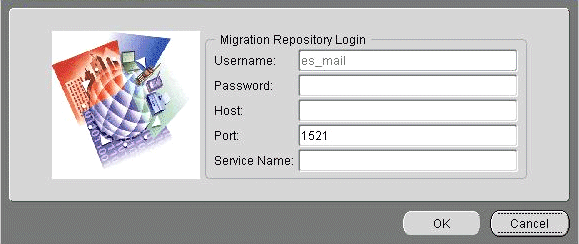
Text description of the illustration image3th.gif
Specify the following information to log in to the migration repository:
es_mail user is es.After you enter the required information, click OK.
The Oracle Email Migration Tool screen displays.
The Migration Setup Wizard collects details for the source and target domains; information for setting specific migration options; and notification of successful migration.
Select Tools > Migration Setup from the Migration Tool menu bar to start the Migration Setup Wizard and display the Welcome screen.
The following Migration Setup Wizard steps are described in this section:
|
Note: All of the following steps are not required. The number of required steps is determined by choices made in Step 1. |
Click Next to display the Mail System Objects screen, shown in Figure 3-2.

Text description of the illustration imageb5m.gif
Specify the following information in the Mail System Objects screen:
After you finish entering the information, click Next to display the Migration Options screen, shown in Figure 3-3.
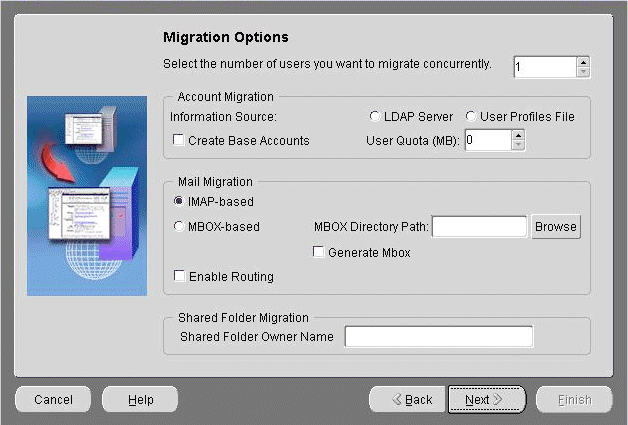
Text description of the illustration imageldu.gif
Specify the following information in the Migration Options screen:
The number you choose here specifies the number of reader threads reading from an IMAP source. This number is the upward limit of users that can be migrated at the same time. For example, if you select 100 as the number of users you want to migrate concurrently, 100 users are migrated concurrently at any one time during the migration process.
When you create batches for migration, the number of users in a batch is mutually exclusive of the number of users migrating concurrently. For example, if you create a batch of 500 users and select 100 as the number of users migrating concurrently, at most, 100 users at a time are migrated out of the batch of 500.
The number of concurrently migrating users you choose depends upon the resources at your disposal. The size of the number will greatly affect the speed and efficiency with which the Migration Tool performs its tasks, such that the larger the number the more resources will be consumed.
See Also:
|
|
Note: The Oracle eMail Server 5.2 Splug-in packaged with this release of the Migration Tool does not generate MBOX files. |
Although the MBOX option is chosen, the Migration Tool does not immediately extract the file to the target disk. Instead, the Migration Tool assumes that the extracted files are already on the disk in the specified location.
This feature is useful for extracting MBOX files from a Microsoft Exchange system, moving them to an intermediate store on another machine, and then loading the file into the target Oracle Email server.
| See Also:
"Viewing Log Files" for information on viewing the logs associated with MBOX file generation |
| See Also:
"Performing a Two-Phase Migration" for more information about two-phase migration |
When you finish entering the information, click Next to display the Notification screen, shown in Figure 3-4.
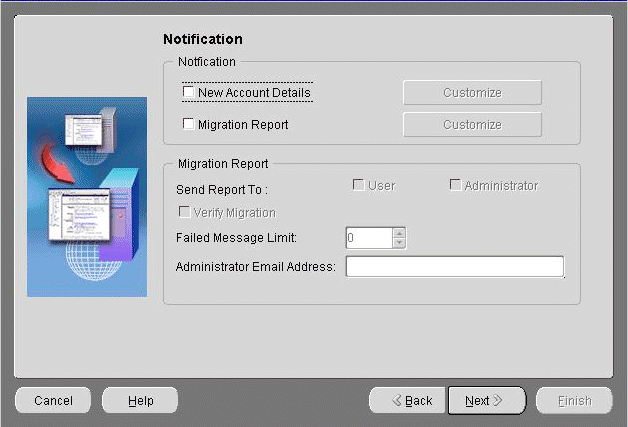
Text description of the illustration imageu4c.gif
Notifications are e-mail messages that inform users about migration events.
In the Notification section, select either New Account Details, Migration Report, or both.
|
Note: If you choose to run a two-phase migration, do not select either New Account Details or Migration Report. |
| See Also:
"Performing a Two-Phase Migration" for more information about two-phase migration |
Click the Customize button to add header and footer notes to the notification.
If you choose to send a migration report to the administrator, enter their target user ID in the Administrator Email Address field.
Click the Customize button to add header and footer notes to the notification.
When this option is selected, the Migration Tool compares the SMTP message ID of every message that is present on the target account with the source account. A report is generated from this comparison and is sent as part of the Migration Report.
| See Also:
"Verifying Migration" for more information about migration verification |
When you finish entering the information, click Next to display the Mail Services screen, shown in Figure 3-5.
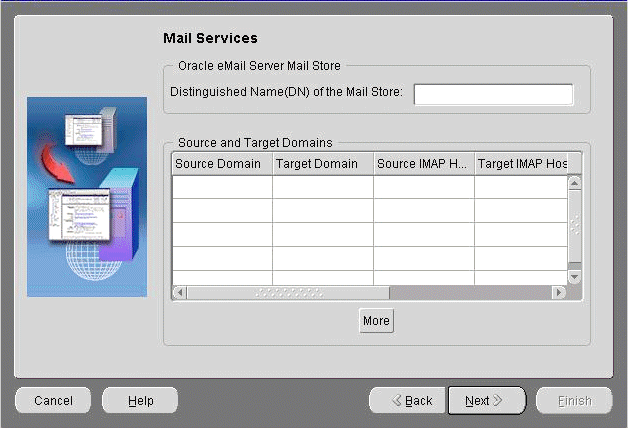
Text description of the illustration imagesd7.gif
Specify the following in the Mail Services screen:
|
Note: Depending on your selections in the previous steps, the following text boxes are enabled on an as-needed basis. |
The data that belongs to a source domain is created on the target domain to which this source domain is mapped. For example, all objects belonging to both us.oracle.com and uk.oracle.com are created under oracle.com.
dc=oracle,dc=com, for a domain called oracle.com. The Migration Tool creates base account entries under the DN of the LDAP entry. Each domain has a separate DN.When you finish entering the information, click Next to display the Source Directory Server screen, shown in Figure 3-6.
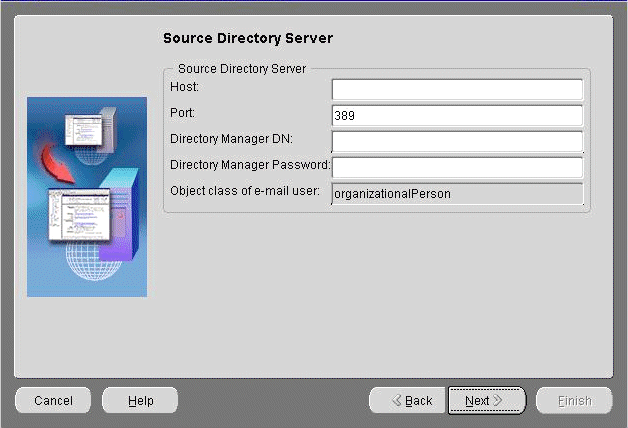
Text description of the illustration image4m3.gif
Specify the following source LDAP server information in the Source Directory Server screen:
The default port number for LDAP is 389. Update the port number if your port number is different.
Leave the Directory Manager DN and the Directory Manager Password fields empty if the source LDAP server supports anonymous login.
| See Also:
Oracle Email Administrator's Guide for more information about schema |
When you finish entering the information, click Next to display the Target Directory Server screen, shown in Figure 3-7.
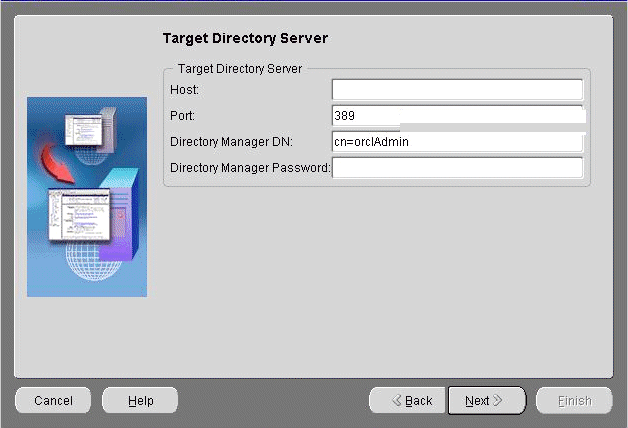
Text description of the illustration imaged0c.gif
Specify the following target Oracle Internet Directory information in the Target Directory Server screen:
The default port number for LDAP is 389. Update the port number if your port number is different.
When you finish entering the information, click Next to display the Username Generation screen shown in Figure 3-9.
|
Note: Depending upon choices you made in previous steps, the next screen to display is the LDAP Schema Mapping screen, shown in Figure 3-8. |
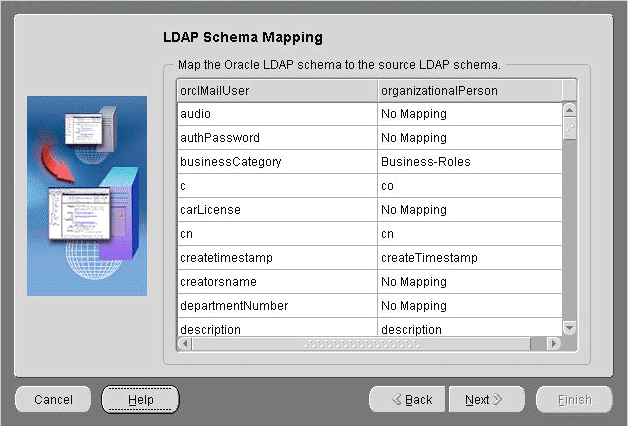
Text description of the illustration imageadm.gif
On Oracle Email, an e-mail account is described by the orclperson object class. This object class has some mandatory attributes you must map to source directory attributes. These mandatory attributes include:
Mandatory Attributes: Click the source attribute on the right to display a list of mapping choices and select the mapping that you want to update the source attribute.
Non-Mandatory Attributes: Attributes that are not mandatory on the target Oracle Internet Directory have the option No Mapping displayed in the right column. Click the drop-down list to display a list of attribute choices to which to map if you want to map a non-mandatory attribute.
|
Note: You need only map these attributes once, because the Migration Tool saves the values for the subsequent batches. |
When you finish entering the information, click Next to display the Username Generation screen, shown in Figure 3-9.
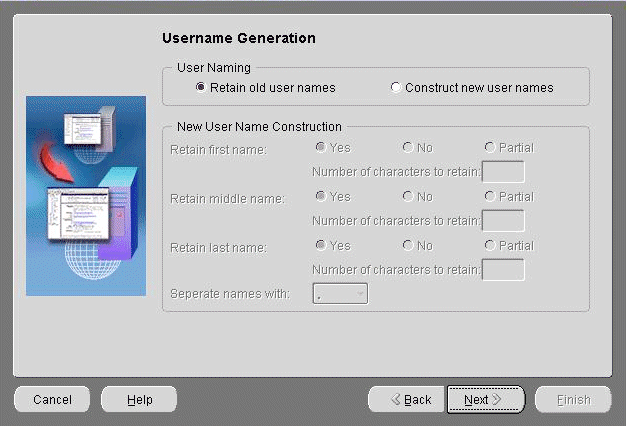
Text description of the illustration imagegdl.gif
Specify the following information in the Username Generation screen:
To generate new account user names, select one of the following choices from the User Naming section:
If you choose to have the Migration Tool construct new user names, you must also supply the rules for user name generation in the New User Name Construction section.
When supplying rules for new user name construction, you can choose to retain the first, middle, or last names, or any combination of the three. Select the appropriate Yes button to retain any of the three names.
You can also retain only part of a name by selecting the Partial button. Specify the number of characters you want to use in the Number of characters to retain field beneath each name.
You must also choose a separator character. To select a separator character, click the Separate names with drop-down list.
When you finish entering the information, click Next. The Summary screen displays. Click Finish to quit the Migration Setup Wizard and display the Oracle Email Migration Tool screen.
If the Migration Tool detects any duplicate target user names (also called name conflicts) when creating accounts in the target Oracle Internet Directory, it logs an error and does not create the duplicate account.
Duplicate target user name errors (name conflict errors) can only be avoided if user name generation rules are chosen so that unique target user names are generated.
To resolve name conflicts, perform the following steps:
When all accounts have been successfully created, proceed to creating batches and migrating user data.
Any changes you make take effect after you cancel and restart the migration.
You cannot modify migration parameters during the migration.
|
Note: If two or more instances of the Migration Tool are running against the same repository, all instances except one must be shut down before modifications to the migration parameters can proceed. |
To modify migration parameters, do the following:
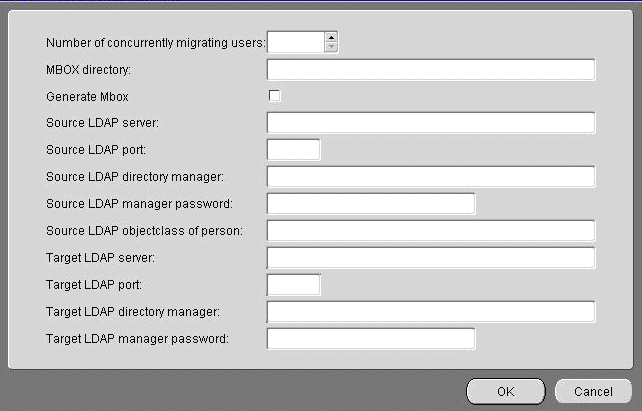
Text description of the illustration imagench.gif
To migrate account information from the source directory server to Oracle Email, do the following:
users.xml.
|
Note: If you selected User Profiles File from the Migration Options Screen, select Extract > User Profiles. |
See Also:
|
text.log file located in the log/migration/uniquenumber directory. Any errors that occur during account migration are logged in the text.log file as administrator error messages.users.xml into the repository.text.log file located in the log/migration/uniquenumber directory. Any errors that occur during account migration are logged in the text.log file as administrator error messages.
| See Also:
Oracle Collaboration Suite Administrator's Guide for descriptions of error messages |
If a user's data in the user-list file causes account migration of this user to fail, you can modify the user's details and attempt to remigrate the batch after editing.
To modify user details, do the following:
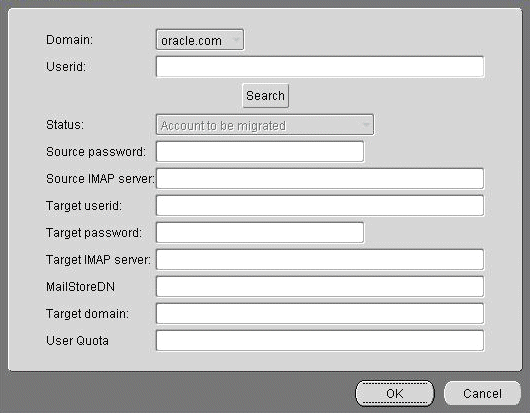
Because migration of user accounts and messages involves transferring large amounts of data and is, therefore, time consuming, users must be transferred from the old system to the new in the least possible amount of time.
The migration tool provides a two-phase migration option to achieve these conflicting goals that transfers messages from the old system to the new Oracle system in two phases.
This section contains the following topics:
All users' messages from the source system are written into into the target Oracle Email system. User accounts, however, are not actually populated with messages, nor are their folders created. In this phase all the message bodies will be transferred into the Oracle Email system. This is typically done in the background over several days while users continue to use their old accounts.
To start pre-migration, do the following:
| See Also:
"Step 2: Specifying Migration Options" for more information about message routing |
In Phase II, the Migration Tool takes advantage of the message sharing capability of Oracle Email to quickly populate users' folders with the messages that were transferred in the first phase.
This phase typically involves only minimal housekeeping updates to the e-mail store and folder creation, and can be done over a weekend. During Phase II, the following operations are performed:
Follow the procedures in "Task 11: Migrating Data" to perform the Phase II of migration.
shared_folders.ldif file in the files directory.public_aliases.ldif file in the files directory.distribution_lists.ldif file in the files directory.text.log file located in the log/migration/uniquenumber directory. Any errors that occur during mail system object extraction are logged in the text.log file as administrator error messages.Once users are created, you must group them into batches for migration.
This section contains the following topics:
Using the Migration Tool, you can create a batch either by designating the number of users for each batch or by creating a custom batch.
Batch creation is done on a domain basis.
To create a batch by domain, do the following:

After you create the batches, you can view them by expanding the domain node on the Migration Tool screen to display all the batches in the domain.
| See Also:
"Task 11: Migrating Data" for information about scheduling batches for migration |
To view users in a batch, expand the domain node and the batch node to view the users in the batch, as shown in Figure 2-5, "Migration Tool Screen with User Information Displayed".
Prior to migrating shared folders, ensure that the following tasks are complete:
| See Also:
"Task 5: Extracting Mail System Objects from the Source System" to generate the shared folder file |
To migrate shared folders, do the following:
text.log file located in the log/migration/uniquenumber directory. Any errors that occur during shared folder migration are logged in the text.log file as administrator error messages.
To cancel migration of shared folders, click Cancel on the status dialog that displays when you start to migrate mail objects.
Prior to migrating public aliases, ensure that the following tasks are complete:
| See Also:
"Task 5: Extracting Mail System Objects from the Source System" to generate the public aliases file |
To migrate public aliases, do the following:
text.log file located in the log/migration/uniquenumber directory. Any errors that occur during public aliases migration are logged in the text.log file as administrator error messages.
To cancel migration of public aliases, click Cancel on the status dialog that displays when you start to migrate mail objects.
Prior to migrating distribution lists, ensure that the following tasks are complete:
| See Also:
"Task 5: Extracting Mail System Objects from the Source System" to generate the distribution lists file |
There are two phases to distribution list migration:
The status bar displays immediately, and shows progress when distribution lists are being populated with users. For example, when the status bar shows that 50% of the distribution lists have been migrated, it means all of the distribution lists have been created and 50% of the distribution lists have been populated with users.
To migrate distribution lists, do the following:
text.log file located in the log/migration/uniquenumber directory. Any errors that occur during distribution list migration are logged in the text.log file as administrator error messages.
To cancel migration of distribution lists, click Cancel on the status dialog that displays when you start to migrate mail objects.
|
Note: WebMail Address Book migration is available only for Oracle eMail Server to Oracle Email migrations. This migration can be run only for users using the 5.2.1 WebMail client. |
The Migration Tool can migrate the private address books created by users using their Oracle eMail Server 5.2.1 WebMail clients. Migration of the WebMail address book of each user involves migrating both the private aliases and private distribution lists that users have.
Prior to migrating address books, ensure that all user accounts have been migrated.
To migrate WebMail address books, do the following:
text.log file located in the log/migration/uniquenumber directory. Any errors that occur during address book migration are logged in the text.log file as administrator error messages.
To cancel migration of address books, click Cancel on the status dialog that displays when you start to migrate address books.
Prior to migrating data you must schedule your batches for migration.
To schedule a start time for batch migration, do the following:
|
Note: You can schedule multiple batches to migrate in parallel by scheduling them to start at the same time. |
To start data migration, select Migrate > Migrate User Data from the Migration Tool menu bar.
To cancel migration, select Migrate > Cancel Migration from the Migration Tool menu bar.
View the text.log file located in the log/migration/uniquenumber directory. Any errors that occur during data migration are logged in the text.log file .
Upon completion of migration, the administrator must perform the following tasks:
You must change the mail exchanger (MX) record in order to redirect e-mail to the new system.
You can verify migration of individual users' accounts and data using one of several methods of comparison. This helps the administrator to verify the validity of the overall migration, and is also helpful to support personnel when users complain of discrepencies in their accounts.
|
Notes:
|
To access the Verification screen shown in Figure 3-13, select Tools > Verify New Accounts from the Migration Tool menu bar.
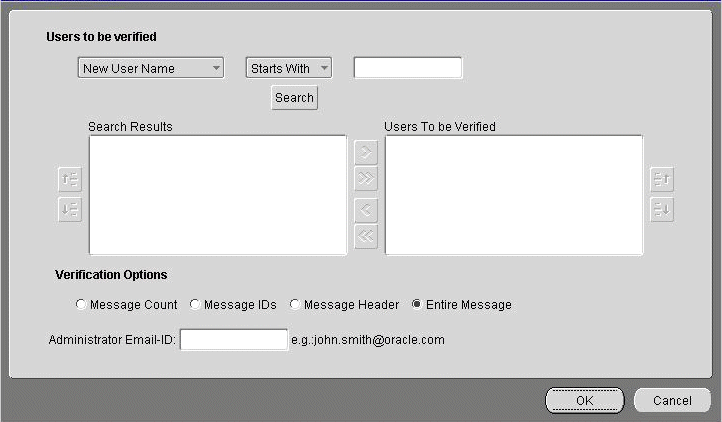
Text description of the illustration imageeju.gif
You can populate the Users To Be Verified field using the search feature. The search feature enables you to search for specific users by entering user name, domain, or batch in the adjacent field. Click Search.
The results of your search display in the Search Results field. Select the users you want to verify and click the Right Arrow button to populate the Users To Be Verified field.
You can shut down the Microsoft Exchange servers upon completion of migration only after you determine that you no longer need routing rules set up on the source e-mail system.
In cases where you have multiple Microsoft Exchange servers, you can move users from whichever machine they reside, to one single machine as their data is migrated to Oracle Email.
| See Also:
Microsoft Exchange documentation for information about moving users from one machine to another |